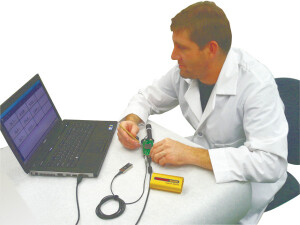by
Loren Bonner, DOTmed News Online Editor | July 09, 2012

Radcal’s Chris Bonefielld
working on an Accu-Gold order
From the July 2012 issue of HealthCare Business News magazine
During a May 18 webinar hosted by the Joint Commission, George Mills, the Commission’s director of engineering, made a plea with attendees in the field of clinical engineering. He urged them to fill out a questionnaire that would be used to explain to the Centers for Medicare and Medicaid Services that there’s already a safe medical equipment maintenance process in place to inspect, test and maintain equipment and utility systems in health care facilities around the country.
Since 1994, the Joint Commission has consistently allowed for a risk-based process to evaluate an organization’s equipment inventories, preventive maintenance strategies and assignment of preventive maintenance frequencies. But ever since CMS clarified its guidelines in a December 2011 directive, which requires hospitals to strictly adhere to manufacturers’ recommendations, the process of maintaining clinical equipment has received considerable attention from a host of industry players.



Ad Statistics
Times Displayed: 136905
Times Visited: 7941 MIT labs, experts in Multi-Vendor component level repair of: MRI Coils, RF amplifiers, Gradient Amplifiers Contrast Media Injectors. System repairs, sub-assembly repairs, component level repairs, refurbish/calibrate. info@mitlabsusa.com/+1 (305) 470-8013
“CMS has always said that if you receive funds from us,you will maintain equipment in your facility according to manufacturers’ recommendations,” says Tim Ritter, senior project engineer at ECRI Institute. “A lot of people didn’t know that, it wasn’t widely recognized.” (ECRI Institute held a similar webinar on the subject in mid February with the title: Should the Centers for Medicare & Medicaid Services revise its new directive on the preventive maintenance of medical devices?)
Manufacturers’ recommendations have always been the starting point for clinical engineering departments’ maintenance process. But over the years, the Joint Commission — which accredits the majority of U.S. health care facilities — allows maintainers of equipment to deviate from these recommendations as their experience warrants.
“If over the years, they found that certain technologies weren’t failing in certain ways, they could reduce their testing or expand the interval for testing,” says Ritter.
The Joint Commission, officially deemed by CMS to conduct testing certification on their behalf, backs an evidence based approach. While placing a higher priority on life-support devices, like defibrillators, clinical engineering personnel are permitted to judiciously decide if and how often they need to maintain devices that are lower-risk to patients.
“Over the past 17 years, there has not been an adverse event associated with the Joint Commission methodology for servicing both life support and non-life support equipment. The process that we have set in place for hospitals to follow is reliable and provides safe outcomes for patients,” says Mills.


Todd Schmechel
CMS vs Biomed?
July 16, 2012 04:36
I have found hospitals that have really gone too far with their experience based PM's. Some are running certain items to fail, then PM'ing them. That is no way to save money. There needs to be a middle ground between what CMS mandated and some of the extremes I've experienced.
to rate and post a comment